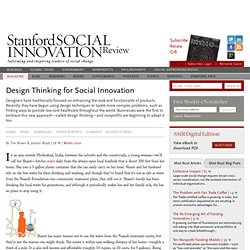

Design for Social Impact: What Does It Mean and Why Should We Care? Guest blogger Jocelyn Wyatt works for the design firm IDEO, leading its base of the pyramid projects.

Prior to joining IDEO, Jocelyn was an Acumen Fund Fellow in Kenya. She holds a MBA from Thunderbird. Jocelyn blogs at Design and Reach. By Jocelyn Wyatt As NextBillion.net mentioned last week, The Rockefeller Foundation and IDEO recently presented their research on how design firms can get more involved in social sector work. Before I joined IDEO, I wondered (like most of you probably do) what application design could have to addressing some of the world’s largest problems. During the course of our work with Rockefeller, we had 142 conversations with social entrepreneurs, foundations, management consultants, academics, writers, and designers. Three aspects of design thinking that are particularly salient for social enterprises are empathy, prototyping, and storytelling. Prototyping is about building to think and helps us get to answers faster.
The Empathy Economy. By Bruce Nussbaum You can't Six Sigma your way to high-impact innovation, but you can design your company to generate products and services that provide great consumer experiences, top-line revenue growth, and fat profit margins.

That's the sometimes-painful message CEOs in America are learning today. Quality-management programs can't give you the kind of empathetic connection to consumers that increasingly is the key to opening up new business opportunities. All the B-school-educated managers you hire won't automatically get you the outside-the-box thinking you need to build new brands -- or create new experiences for old brands.
The truth is we're moving from a knowledge economy that was dominated by technology into an experience economy controlled by consumers and the corporations who empathize with them. "MASTERS OF HEURISTICS. " Understanding, empathy, problem-solving -- these are the heuristic managerial skills needed today, argues Martin, who advises Procter & Gamble (PG) CEO A.G. What is Design Thinking, Really? If you’re a businessperson or someone interested in understanding how to facilitate innovation, you’ve probably heard of “design thinking” by now.

Coined by IDEO’s David Kelley, the term refers to a set of principles, from mindset to process, that can be applied to solve complex problems. I’ve seen articles lately ranging from those that highlight its potential, [Design Thinking for Social Innovation, How does design thinking give companies a competitive advantage?] To those that warn of it’s impending failure as a practice [Why Design Thinking Won't Save You , The Coming Boom and Bust of Design Thinking]. I’ve been eager to enter into the conversation, especially because some of the arguments around the topic don’t make sense to me and I wanted to know why.
Change by Design, written by IDEO’s CEO Tim Brown, was on my winter reading list anyway, so I decided to finish it before bringing in my own perspectives. I just got through the book a few days ago, and feel like I “get it.” Design Thinking for Social Innovation. Designers have traditionally focused on enhancing the look and functionality of products.

Recently, they have begun using design techniques to tackle more complex problems, such as finding ways to provide low-cost healthcare throughout the world. Businesses were the first to embrace this new approach—called design thinking—and nonprofits are beginning to adopt it too. In an area outside Hyderabad, India, between the suburbs and the countryside, a young woman—we’ll call her Shanti—fetches water daily from the always-open local borehole that is about 300 feet from her home. She uses a 3-gallon plastic container that she can easily carry on her head. Shanti and her husband rely on the free water for their drinking and washing, and though they’ve heard that it’s not as safe as water from the Naandi Foundation-run community treatment plant, they still use it.
Shanti has many reasons not to use the water from the Naandi treatment center, but they’re not the reasons one might think. Ideation.